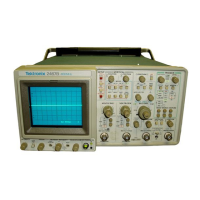Performance Check—2465B/2467B Service
TRIGGERING
Equipment Required (see Table 4-1)
Primary Leveled Sine-Wave Generator (Item 2)
Secondary Leveled Sine-Wave Generator (Item 4)
Function Generator (Item 5)
10X Probe (supplied with 2465BCT/2467BCT) (Item 7)
T-Connector (2 required) (Item 8)
Precision 50 fi BNC Cable (Item 9)
50
Q
BNC Cable (4 required) (Item 10)
Dual-Input Coupler (Item 11)
50
12
BNC Termination (2 required) (Item 12)
Subminitiare Probe Tip-to-BNC Adapter (Item 13)
10X Attenuator (Item 18)
Adapter (Item 25) (2 Required)
Initial Control Settings.
Control settings not listed do not affect the procedure.
a. Set:
NOTE
Select channels to set VOLTS/DIV.
VOLTS/DIV
CH 1
CH 2
CH 1 and CH 2 VAR
CH 3 and CH 4
100 mV
500 mV
In detent
0.5 V
Delta
At and AV
TRACKING
Trigger
HOLDOFF
LEVEL
SLOPE
MODE
SOURCE
COUPLING
Off (press and release
until associated readout
is off)
Off
B ENDS A (fully CW)
Midrange
+ (plus)
AUTO LVL
VERT
DC
1.
Check A and B Triggers.
VERTICAL MODE
CH 1
CH 2, CH 3, CH 4,
ADD and INVERT
CHOP/ALT
20 MHz BW LIMIT
Input Coupling
CH 1 and CH 2
Horizontal
A SEC/DIV
SEC/DIV VAR
X10MAG
TRACE SEP
On
Off
ALT
Off
1 Mfi DC
2
ixs
(knob in)
In detent
Off
Fully CW
NOTE
The Trigger Level Readout Accuracies are checked
in the Vertical Performance Checks.
a. Refer to Table 4-5 to determine what the A Trigger
requirements are and at what frequencies various checks
are made.
b. Using a 50 Q BNC cable, connect one of the follow-
ing test generators to the CH 1 input connector. Select the
generator that produces the proper frequency range for
the conditions being tested as called out in Tables 4-5 and
4-6.
When using the leveled sine-wave generators (items 2
and 3 below), the output must be terminated into 50Q
(either the 50 fi input coupling or a 50 fi termination may
be used).
4-15

